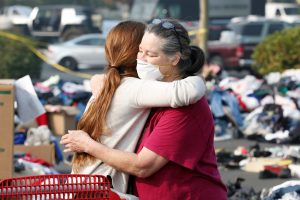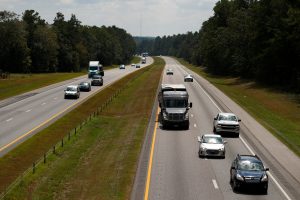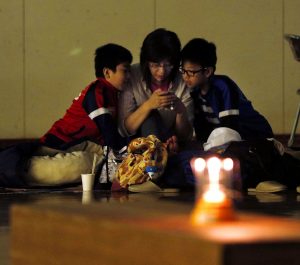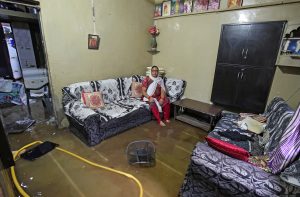
By Kiyoshi Takenaka and Issei Kato
KURASHIKI, Japan (Reuters) – Rescuers in Japan dug through mud and rubble on Monday, racing to find survivors after torrential rain unleashed floods and landslides that killed at least 114 people, with dozens missing.
Prime Minister Shinzo Abe canceled an overseas trip to deal with Japan’s worst flood disaster since 1983, with several million people forced from their homes.
Officials said the overall economic impact was not clear.
Rain tapered off across the western region on Monday to reveal blue skies and a scorching sun that pushed temperatures well above 30 Celsius (86 Fahrenheit), fuelling fears of heat-stroke in areas cut off from power or water.
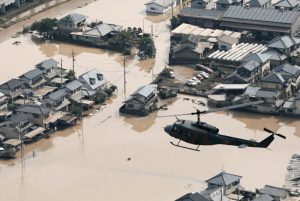
A helicopter flies over Mabi town which was flooded by the heavy rain in Kurashiki, Okayama Prefecture, Japan, in this photo taken by Kyodo July 9, 2018. Mandatory credit Kyodo/via REUTERS
“We cannot take baths, the toilet doesn’t work and our food stockpile is running low,” said Yumeko Matsui, whose home in the city of Mihara, in Hiroshima prefecture, has been without water since Saturday.
“Bottled water and bottled tea are all gone from convenience stores and other shops,” the 23-year-old nursery school worker said at an emergency water supply station.
Some 11,200 households had no electricity, power companies said on Monday, while hundreds of thousands had no water.
The death toll reached at least 114, NHK public television said, with 61 people missing.
Though the persistent rain had ended, officials warned of sudden showers and thunderstorms as well as of more landslides on steep mountainsides saturated over the weekend.
Chief Cabinet Secretary Yoshihide Suga said Prime Minister Abe had canceled his trip to Belgium, France, Saudi Arabia and Egypt because of the disaster. He had been due to leave on Wednesday.
Industry operations have also been hit, with Mazda Motor Corp saying it was forced to close its head office in Hiroshima on Monday.
The automaker, which suspended operations at several plants last week, said the halt would continue at two plants until Tuesday because it could not receive components, although both units were undamaged.
Daihatsu, which suspended production on Friday at up to four plants, said they would run the second evening shift on Monday.
Electronics maker Panasonic said operations at one plant remained suspended after the first floor was flooded.
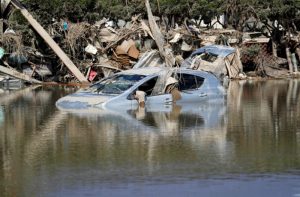
A submerged Toyota Motor’s car is seen in a flooded area in Mabi town in Kurashiki, Okayama Prefecture, Japan, July 9, 2018. REUTERS/Issei Kato
GRIM RECOVERY
Refineries and oil terminals were not affected but blockages in roads leading to one Showa Shell oil terminal in Hiroshima caused gas and diesel shortages nearby.
Shares in some companies fell but losses were modest, with Mazda even gaining as investors bet damage was limited.
“If the rainfall affects supply chains, there will be selling of the affected stocks,” said Norihiro Fujito, chief investment strategist at Mitsubishi UFJ Morgan Stanley Securities.
“Otherwise, the impact will be limited.”
Elsewhere, people soldiered on with a grim recovery.
The floodwaters slowly receded in Kurashiki city’s Mabi district, one of the hardest hit areas, leaving a thick coat of brown mud and cars turned over or half-submerged, as residents returned to tackle the mess.
“I’ve never experienced anything like this is my life, and I’ve lived for more than 70 years,” said Hitoko Asano, 71.
“The washing machine, refrigerator, microwave, toaster, PC – they’re all destroyed,” she said as she cleaned her two-story house.
“Clothes in the drawers were all damaged by muddy water, we won’t even bother to wash them. I can’t help wondering how much it’ll cost to repair this.”
At one landslide in Hiroshima, shattered piles of lumber marked the sites of former homes, television images showed. Other homes had been tossed upside down.
Although evacuation orders were scaled sharply back from the weekend, some 1.7 million people still face orders or advice to keep away from homes, fire and disaster officials said.
The economic impact was being assessed.
“I’m worried there could be a significant impact on production, consumption and tourism,” Toshiro Miyashita, Bank of Japan’s Fukuoka branch manager, who oversees Kyushu region, told a news conference.
Japan monitors weather conditions and issues warnings early, but its dense population means every bit of usable land is built on in the mostly mountainous country, leaving it prone to disasters.
(Additional reporting by Elaine Lies, Shinichi Saoshiro, Naomi Tajitsu, Ayai Tomisawa, Linda Sieg, Osamu Tsukimori, Leika Kihara and Tetsushi Kajimoto; Writing by Elaine Lies; Editing by Clarence Fernandez, Robert Birsel)


